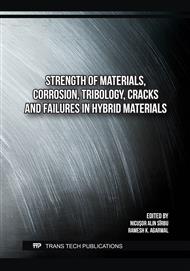p.21
p.27
p.35
p.45
p.55
p.65
p.77
p.89
p.101
Investigation of the High Cycle Fatigue Behaviour of Aluminium Alloy Clinched Joints
Abstract:
The current work investigates the high cycle fatigue behaviour of two aluminium alloys (5754-H22, 6082-T4) under a tensile shear-loading condition joined by clinching methods. Clinching is a rapidly growing technology in the automotive, electronics, and household appliances industries. Several industrial sectors apply this technology to join lightweight materials due to their cost-effective and environmentally friendly characteristics that involve interlocking two (or more) sheets of materials without the need for additional fasteners or adhesives. Clinched joint specimens were prepared using a standard clinching process, ensuring consistent joint geometry and interfacial contact. The joined sheets have been produced in three levels: a similar pair of 5754, a similar pair of 6082, and a combined of 5754-6082, with a bottom thickness of 0.5 mm and a base TOX tool dimension. Subsequently, the high cycle fatigue behaviour of the clinched joints was assessed through cyclic loading tests. The ΔL-N curves were constructed to illustrate the relationship between the number of cycles to failure and the applied load range levels. Both the fatigue and the previous tensile strength tests were conducted with an MTS-type electro-hydraulic materials testing equipment. During the constant load amplitude investigations, the stress ratio was constant (0.1). Furthermore, a sinusoidal loading waveform with a frequency of 30 Hz were applied for the entire test series. Additionally, all tests were carried out at room temperature and in laboratory air. The results from the tests indicated that both the tensile shear and the high cycle fatigue resistance, in other words, both the static and cyclic behaviour of clinched joints were appropriate. In conclusion, this investigation provides valuable insights into the mechanical performance of aluminium alloy clinched joints under both loading conditions. The findings emphasize the importance of joint design optimization for improving durability and reliability in structural applications Results, show that the high cycle fatigue strength of the clinched joints represents competitive fatigue resistance than traditional welding joints.
Info:
Periodical:
Pages:
65-76
Citation:
Online since:
November 2025
Authors:
Keywords:
Price:
Сopyright:
© 2025 Trans Tech Publications Ltd. All Rights Reserved
Share:
Citation:


